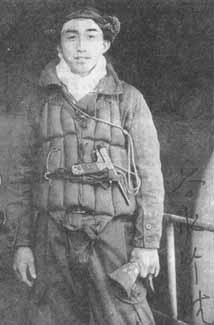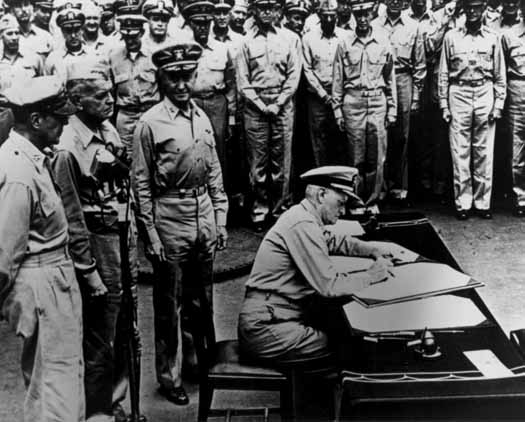Takeo Tanimizu


"We have awakened a sleeping giant and instilled
in it a terrible resolve."
Admiral Isoroku Yamamoto
upon bombing Pearl Harbor by surprise
and embarking upon war with the United States"WAR!"
Listen to the Emepror Tojo's Declaration of War
against the United States and Great Britain.
92.9kb *.wav
Only in his early twenties at the time, Japanese fighter pilot Takeo Tanimizu was said to have shot down 32 enemy aircraft in the Pacific theater of operations during the Second World War. Night after night, year after year, he flew his Mitsubishi Zero aircraft against his American counterparts in support of a government gone militaristically berserk. I can still hear my father - a young child in a WWII American environment which demonized "the Japs" - protesting bitterly for my inclusion of Takeo Tanimizu into my heroes section. "What, are you doing," he would say, "eulogizing an enemy of this country with American blood on his hands? You must be crazy!" However, I stand by my decision. I include Tanimizu not for his undisputed prowess as a fighter pilot nor for his efforts to further the blatantly cruel government of Imperial Japan. I admire Tanimizu for his humanity and for his sense of deep regret over having killed so many men during his remarkable military career - read on further and you will see what I mean. It was only the war that made Tanimizu and his American counterparts adversaries, Tanimizu says: "They were the enemy, so if you didn't get them, they would get you." Moreover, Tanimizu also showed compassion as a fighter pilot, once zooming in low and throwing his life preserver to U.S. Marine Captain Harvey Carter of Glendale, California, who had just been shot down and was swimming in the ocean. Although he served his Emperor to the best of his abilities and survived the war and eventually lived to a ripe old age, Tanimizu all through the rest of his years was to lament his actions and pray nightly at the small Buddhist altar in his home for the souls of the men he had killed.
Tanimizu flew one fateful mission against the Americans that connected emotionally with him only five decades later. On August 31, 1944, in the dead of night he jumped into his aircraft and attacked a formation of 11 B-24 bombers based at the 14th Air Force field in Liuzhou, China who were on their way to bomb the Imperial Japanese Navy base at Takao - what is now Kaohsiung, Taiwan. In the ensuing action, Tanimizu shot down one American aircraft and badly damaged another. The damaged bomber ultimately made it back to
China where it crashed into the side of Maoer mountain in the Guangxi province. There it remained disappeared from history for more than 52 years until October 2, 1996, when peasant farmers found the wreckage while hunting for medicinal herbs. U.S. military specialists were eventually able to identify the bodies of Lt. George Pierpont and his crew and fly their remains back to the United States for a proper military burial.
Five decades later, living quietly in Osaka, Japan after suffering a mild stroke, Tanimizu was overcome by emotion when he learned of the discovery of the remains of the dead men in the Chinese countryside. "I did fight American planes over Takao," Tanimizu said through tears during a telephone interview, "I know one crashed into the ocean, but I don't know what happened to the other." However, with the new information Tanimizu clearly recognized that he was responsible for the deaths of those men so many years ago. An old man at 76 years of age, in response to being asked if he had any words for the families of the men he killed, Tanimizu replied sobbing into the telephone, "I can't say anything. The only thing I can say about the people who were found after 50 years is to pray that their souls find happiness in the next world."
The Second World War in the Pacific theater of operations was a war bitterly fought by both sides. It was a war of professionals, and little quarter was asked for or given in the oceans, skies, and jungles of Asia by the marines, sailors, and airmen who bitterly fought each other there.
Execution of Allied Intelligence Officer by the Japanese
New Guinea, 29 March 1943
"Apparently, he wants to be killed with one stroke of the sword. I hear him say the word 'one'; the Major's face becomes tense as he replies, 'Yes.'"United States Marines Land on Tarawa
20 November 1943
"The flame-thrower, waiting for him, caught him in its withering stream of intense fire. As soon as it touched him, the Jap flared up like a piece of celluloid."Fortunately, the hatred that existed during wartime was not to last. Perhaps there was no single American who did more to defeat Imperial Japan in war than American Admiral Chester W. Nimitz, yet this same man devoted considerable care and time afterwards to help build friendship and understanding between the two former enemies. "Japan was a very worthy and tenacious foe," claimed Nimitz many years after he signed the instrument of Japanese surrender aboard the USS Missouri in Tokyo Bay, "and after we gave her a good drubbing there was no reason to pour salt into the wound." Japan subsequently emerged from defeat to become a fast ally of the United States, helping to cement an alliance that was to provide stability in Northern Asia for the greater part of the twentieth century. I myself - in opposition to my father - grew up in a time when Japan was a friend of the United States. While growing up I ate Japanese food, met the people, practiced their martial arts, etc. and have had a warm feeling towards that country all throughout my life. I am not unique in this experience, and the two cultures have broadly cross-pollinated each other over many years. Trade squabbles notwithstanding, it is indeed difficult to imagine the United States and Japan ever going to war again. If only the bloody conflicts that tragically arise between nations could have more individuals such as Chester Nimitz and Takeo Tanimizu, perhaps old wars would beget new ones less frequently!
Let us keep the image of Takeo Tanimizu in mind in this world where so many of us are called upon to kill perfect strangers for the "good" of our countries. Nobody can change the past, but with a palpable sense of humanity and moral responsibility we can with humility look backwards on past deeds with sadness, acceptance, and forgiveness - this last being the most important. Forgiveness!
Admiral Nimitz accepts Japanese surrender in 1945 aboard the USS Missouri.
![]()

